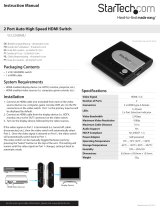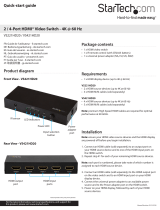
Instruction Manual
4
2. Install RJ45 terminated Cat5e/6 Ethernet Cable
a) Connect an RJ45 terminated Cat5e/6 Ethernet cable (not included) to the RJ45
connector on the Transmitter unit.
NOTE:
If you are using surface cabling, ensure you have enough Category 5e unshielded
twisted pair (UTP) network cabling to connect the Host Unit to the Remote Unit’s
location, and that each end is terminated with a RJ45 connector. The cabling should
not go through any networking equipment (i.e. router, switch).
OR
If you are using premises cabling, ensure that the Category 5 unshielded twisted
pair (UTP) network cabling between the Host Unit and the Remote Unit has been
properly terminated in a wall outlet in each location and there is a patch cable long
enough to connect the Remote Unit and the Host Unit to their respective outlets.
The cabling should not go through any networking equipment (i.e. router, switch).
b) Connect the other end of the Cat5e/6 cable run to the RJ45 connector on the
Receiver Unit.
3. Install Receiver Unit
a) Position the Receiver Unit near the video display (i.e. television, projector).
b) Connect the video source to the HDMI® OUT on the Receiver Unit using an HDMI®
cable.
c) (Optional) If using the Extender to extend one or two 10/100 Network signal(s),
connect the Ethernet cable(s) from the 100Base-T OUT Port(s) on the Receiver Unit
to RJ-45 port on your network device(s).
d) (Optional) If using the Extender kit to transmit an infrared (IR) device signal,
and the device receiving the IR signal is on the Transmitter side. Connect the IR
Transmitter Cable to the IR-TX port on the Receiver Unit, and position the IR sensor
where the remote control will point. If the device receiving the IR signal is on
the Transmitter side, and connect the IR Transmitter Cable to the IR-TX port, and
position the extended IR sensor directly in front of the video source’s IR sensor.
Check the manual of your video source device for the IR sensor location.
4. Your source video image will now appear on the remote video display.



















